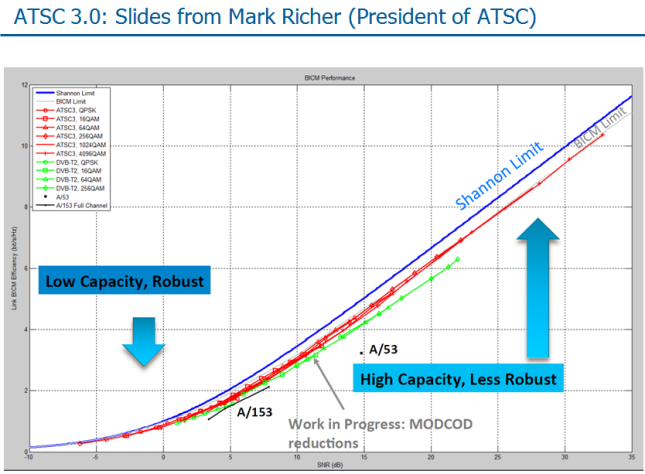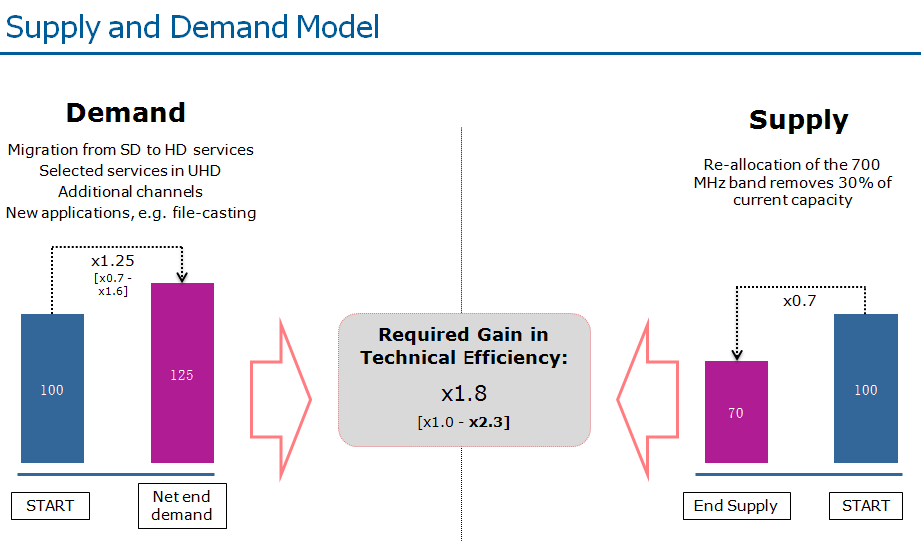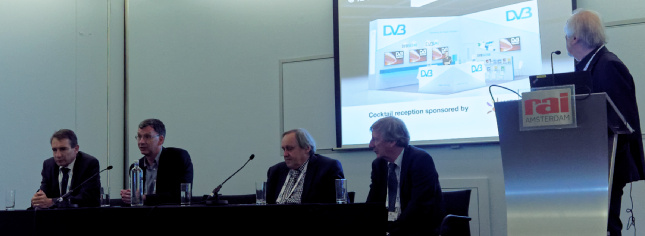Helmut Stein opened the annual DVB IBC press event. Phil Laven, the DVB Chairman, was the first speaker.
Laven started by talking about HEVC – he said that without it, UltraHD would not be possible, but HD services will also appear using HEVC with DVB-T2 as DVB standards are compatible. HEVC is really important for the future of broadcasting and will even be used for standard definition.
He then switched to discuss ATSC 3.0 which has “considerable” similarities with DVB-T2. There is about a single db of difference between ATSC and DVB. ATSC 1.0 and the DVB standards all use MPEG-TS to deliver data in audio and video, but ATSC will use IP transport only. “Should DVB go that way?”, Laven asked. The DVB had a meeting, but it was agreed that it might make sense to switch to IP if you were starting again, but it’s not worth changing at this stage.

Broadcast “ain’t dead” but OTT is increasingly successful. OTT content is being watched on smartphones, tablets and (some) TVs. However it is more expensive – Laven pointed out that the successful BBC iPlayer takes 12% of the broadcaster’s cost of transmissing for 2% share of its audience. The lack of standardised interfaces for OTT content is a big issue – a provider may have to support as many as 700-800 different end devices. “Something needs to be done about it”, Laven said.
Internet is a “best effort” network – there is no “Quality of Service” (QOS) guarantee – so DVB has been working on a DVB MPEG-DASH system for adaptive streaming to cope with this. OTT is good for niche content.
David Wood then came onto talk about UHD in DVB. There are a range of features available in UltraHD and you have to choose which to implement and which to leave. The DVB’s members want a phased approach based on the UltraHD phase 1 4K specification.
Phase 1 of UHD provides for 3840 x 2160 at up to 60 Hz, but with Standard Dynamic Range (SDR). There are two groups of members that need the specs – some want them now, while others want to wait until chips are ready for HFR.
Wood explained what HDR, HFR and WCG are and said that they are important because these three features of visual quality are “immune to viewing distance”. Broadcasters also need to take into account “next generation audio” (NGA) – which is object-oriented and allows for dynamic playback in different formats.
Graham Mills said that there was a question about the future for terrestrial TV. DVB-T2 is very successful, but is used differently in different countries. T2 is used for HD content in the UK, but for mobile TV in Germany, for example.
Hybrid networks are interesting – combining DVB-T2 with 4G/5G or broadband can be a good option the context of finite spectrum.
The DVB conducted a broad survey of the TV industry and related companies. Mills said that there is a potential for some channel increases. Going to HD means you need around 25% extra capacity (taking into account HEVC etc which can help to offset extra channels by compressing more efficiently). Losing the 700Mhz transmission band means that the industry loses 30% of its TV capacity. Therefore there needs to be a boost in “technical efficiency” of a factor of 1.8 average (from 1.0 to 2.3), if you want to balance the increased demand for capacity against the reduction in spectrum.

Evolution of terrestrial TV could be in service enrichment, or maintaining high performance and security. Fifteen areas of opportunity have been identified by DVB and a “Vision” report will be issued by the end of 2015 to point the way.
Peter Siebert said it is often forgotten that DVB also covers IP content. You can use DVB over IP (DVB MPEG-DASH) or IP over DVB (DVB-GSE). DVB MPEG-DASH is a key part of Hbb2.0. A demo on the booth shows both of these being used together to highlight the interoperability
There is also a demo showing how content on portable devices can be supported.
Next there was a panel session.

In response to a question from us, David Wood said that the DVB has a plan to complete the “Commercial requirements” document for HDR by Feb 16, with technical requirements decided by the end of 2016 and that will mean a roll out in 2017 of services. HFR is likely to be later, as the chips simply won’t be available for this until 2018 or 2019. He also pointed out that there needs to be work done on the “best practices” for content creation and grading if you want to avoid consumer problems.
In questions it was confirmed that DVB streams allow alternate codecs. For example, VP9 could be used in a DVB stream. Typically IPR codecs are generally more efficient. In response to a question about the recent announcement of a consortium to develop and promote an open and patent-free codec, because of the issues with HEVC licensing, it was pointed out that is was very hard to ensure that there are no royalties as patents can turn up later. Patent owners may sit on them until there is a big opportunity for income.
The development of UltraHD has been fraught for DVB and for its close neighbour, the EBU. Although some broadcasters want to get things moving, it has been really hard for regulators to settle on standards. One person on the ITU committee pointed out that, at the July meeting, delegates arrived with the intention of choosing a standard for HDR, but by the end of the meeting, there were more options than at the start! Given that many of the same companies that are represented on the ITU panel are also members of the DVB and MPEG, it’s clear that there will be contention. It also seems to us that a number of companies must, inevitably, be disappointed and given the commitment and investment they have put in, they are unlikely to simply walk away and may try to promote their own standards. That will lead to consumer and market confusion. (BR)

